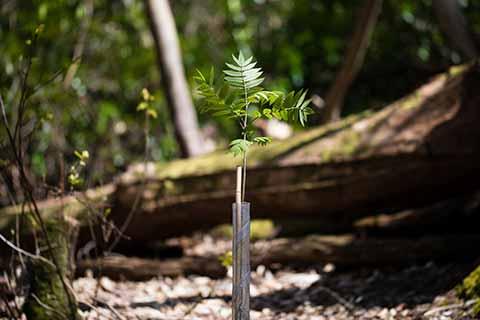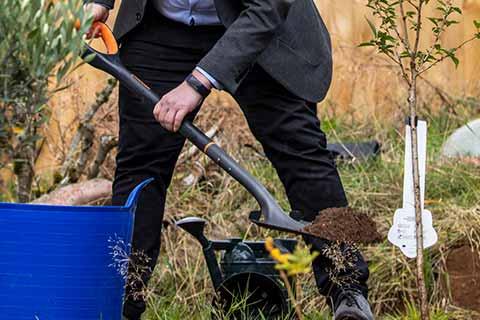How to plant native trees
Planting trees is one of the best things we can all do to help wildlife and the environment. If it's not something you can do at home, look for local community planting schemes to join in with. Trees add beauty, interest, shade and structure to any garden. But there are so many other good reasons to plant them:
- Trees and shrubs of all sizes provide a habitat for birds, insects and mammals.
- They clean the air, soaking up carbon dioxide and releasing oxygen.
- Their blossom, fruit and berries are a valuable food source.
- They protect us from the sun and wind.
- Their roots add structure to soil, preventing erosion and offering some protection against flooding.

Choose the right species
Most trees can grow in a range of conditions, though some prefer particular soil types. Look around your neighbourhood and see what's thriving to get an idea of what you could plant. Don't be put off if you only have a small garden. Simply choose one of many compact species that will only grow as big as you have space for. Small trees and shrubs can even be grown in containers. Ask your tree nursery or garden centre for advice.
Go native
There are lots of benefits to choosing native trees, from supporting local wildlife to reducing your carbon footprint. Long-living trees such as oaks and maples store carbon dioxide really well. If you want something fast-growing, the likes of alder, rowan, hazel, common beech, silver birch and willow are good.
The RSPCA Garden at Chelsea features varieties of maple, birch, cherry, hawthorn and hazel. It also has shrubs like elder and viburnum, which add structure and habitat, with flowers for pollinating insects.
When to get planting
Tree planting season runs between November and March. Over winter they're dormant, so less likely to get damaged. Container-grown shrubs and small trees can be planted year round, but between autumn and spring when it's not too hot is best.
Step-by-step guide
You'll need a spade, plus canes, and non-plastic tree guards or spirals to protect saplings (young trees).
Water the tree's root ball - or pot if it's in one - well before planting.
Dig a hole the same depth as your plant's pot or root ball, but three times as wide.
Place the root ball in the hole. The spot where the trunk meets the root ball should be level with the surface.
Refill the hole with soil, and press it down firmly. This makes sure there are no air gaps so frost can't get in.
Push in a cane next to the tree - not too close because you don't want it to push through the tree's roots.
Take a spiral, open one end and hook it around both the cane and the tree. Carefully wind it up to the top, making sure you don't damage your tree while you do it. Then carefully push down the cane and spiral around 1cm into the ground.

Keep your trees healthy
Tell others where you’ve planted the trees to stop them getting damaged. In the first three years after planting, keep a one-metre diameter around the tree clear of weeds and grass to reduce competition for moisture and nutrients. Water well, especially during dry spells.
Take our pledge!
If you build a bird box in your garden or outdoor space, don’t forget to tell us! Share a photo, tag us on social media, and use the hashtag #WildlifeFriends
Join RSPCA #WildlifeFriend
There are loads of easy ways to get involved and help wildlife. Sign up as a volunteer and start making a difference today.



Find out more about protecting wildlife in your garden
Want more advice like this?
If you want to receive more advice like this straight to your inbox, and keep up to date with the RSPCA and what we do, sign up to our newsletter

